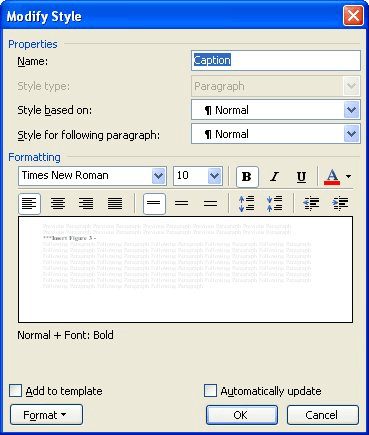Please Note: This article is written for users of the following Microsoft Word versions: 97, 2000, 2002, and 2003. If you are using a later version (Word 2007 or later), this tip may not work for you. For a version of this tip written specifically for later versions of Word, click here: Formatting Captions.
Written by Allen Wyatt (last updated December 16, 2023)
This tip applies to Word 97, 2000, 2002, and 2003
Word includes a captioning feature that allows you to manually or automatically add captions in your document. These captions are typically placed with tables or other objects (such as figures) to identify them. For instance, you might have a caption such as "Figure 2" that appears below a figure.
When you use the captioning feature, Word automatically formats the caption using the Caption style. By default, the Caption style uses the same typeface as your Normal style, except it is bold. If you want to use a different set of attributes for your captions, all you need to do is change the Caption style. Follow these steps if you are using Word 97 or Word 2000:
If you are using Word 2002 or Word 2003, you should instead follow these steps:

Figure 1. The Modify Style dialog box.
WordTips is your source for cost-effective Microsoft Word training. (Microsoft Word is the most popular word processing software in the world.) This tip (623) applies to Microsoft Word 97, 2000, 2002, and 2003. You can find a version of this tip for the ribbon interface of Word (Word 2007 and later) here: Formatting Captions.

Discover the Power of Microsoft Office This beginner-friendly guide reveals the expert tips and strategies you need to skyrocket your productivity and use Office 365 like a pro. Mastering software like Word, Excel, and PowerPoint is essential to be more efficient and advance your career. Simple lessons guide you through every step, providing the knowledge you need to get started. Check out Microsoft Office 365 For Beginners today!
Word can automatically add captions to various elements of your document, such as tables or figures. Here's how to ...
Discover MoreNeed to add a caption after a document element such as a figure or table? You can add and format one manually, or you can ...
Discover MoreWhen using the captioning capabilities of Word, you aren't limited to the three default caption labels provided in the ...
Discover MoreFREE SERVICE: Get tips like this every week in WordTips, a free productivity newsletter. Enter your address and click "Subscribe."
There are currently no comments for this tip. (Be the first to leave your comment—just use the simple form above!)
Got a version of Word that uses the menu interface (Word 97, Word 2000, Word 2002, or Word 2003)? This site is for you! If you use a later version of Word, visit our WordTips site focusing on the ribbon interface.
Visit the WordTips channel on YouTube
FREE SERVICE: Get tips like this every week in WordTips, a free productivity newsletter. Enter your address and click "Subscribe."
Copyright © 2026 Sharon Parq Associates, Inc.
Comments